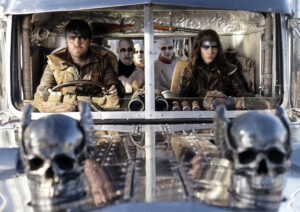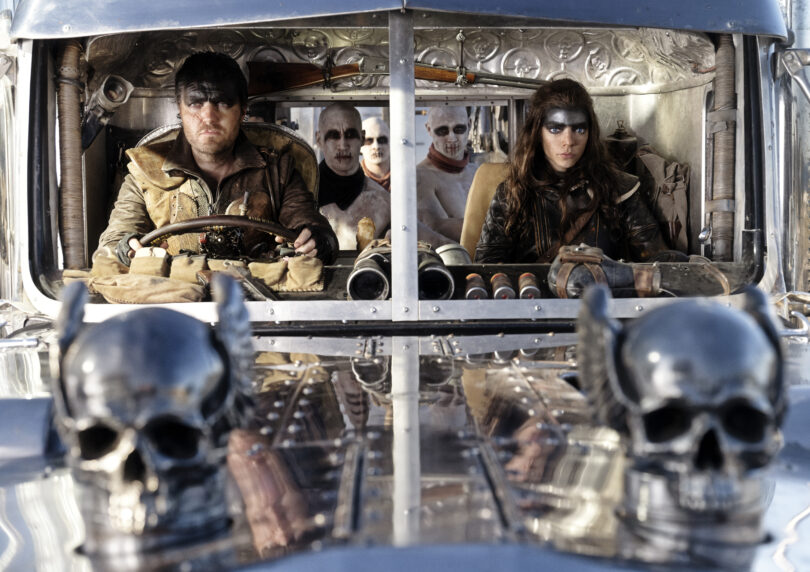Have you ever felt like a supporting player in your own life?
That’s what Furiosa must feel like in “Furiosa: a Mad Max Saga” (R, 148 minutes, in theaters). Anya Taylor-Joy has top billing as the title character, playing the younger version of the badass warrior played by Charlize Theron in the previous movie in the franchise, “Mad Max: Fury Road” (which came out, gulp, nine years ago). Alyla Browne also plays the character, as a child, earlier in the new film.
Both Taylor-Joy and Browne portray Furiosa as the silent type, which might partially account for Chris Hemsworth dominating the movie as the gabby villain Dementus. Dementus, who rides a chariot with three motorcycles in the place of horses, lords over a biker horde that terrorizes the desert wasteland – called, appropriately enough, the Wasteland – in the series’ post-apocalyptic world. Hemsworth chews up the scenery with a flamboyant performance that combines humor and sadism (hey, a warlord’s gotta do what a warlord’s gotta do), which fits in perfectly with the twisted world that Aussie filmmaker George Miller continues to create with the “Max” movies.

Furiosa (Anya Taylor-Joy), Praetorian Jack (Tom Burke) and the War Boys in “Furiosa: a Mad Max Saga.” (Warner Bros. Pictures)
Dementus also delivers a line that really sums up a message of the whole franchise: “When things go bonkers, you have to adapt.” No matter how demented Dementus is, that’s pretty good advice, and Furiosa sure has her share of adapting to do.
The film opens with members of Dementus’ horde kidnapping the child Furiosa so she’ll reveal the location of her home, the Green Place of Many Mothers, a “land of abundance” (with greenery, water, food, etc.). Furiosa’s mother, Mary (Charlee Fraser) – of course it’s Mary, Furiosa being a messianic character – bolts after the bikers intending to save her daughter, kill the abductors, and thereby keep any information about the Green Place location out of the hands of Dementus.
This chase sequence isn’t the most elaborate or action-packed in the film, but it’s the best. With the desert setting and Mary’s crafty way of picking off the horde creeps, it’s like the most riveting kind of choreographed gun battle in an Anthony Mann Western (I’m thinking “Winchester 73”). And, this time, it’s the tough, fearless Mary who overshadows her daughter as the central attraction.

Chris Hemsworth chews the scenery as the villain Dementus in
“Furious: a Mad Max Saga.” (Warner Bros. Pictures)
Afterward, once Browne’s vulnerable youngster turns into Taylor-Joy’s vengeance-seeking heroine, the action does go full-on bonkers when Furiosa winds up on a giant rig, driven by the legendary Praetorian Jack (Tom Burke, who played Orson Welles in “Mank”) and guarded by a team of shirtless, pasty-skinned War Boys, as it endures an attack by helicopter, motorcycles and so forth. This is the stuff director Miller and his “Max” movies are so well-known for, the chase captured with such breakneck speed and relentless violence that it’s absurdly funny.
This time it’s John Ford’s “Stagecoach” on acid.
The problem is, the “Mad Max” freneticism– and the oddball characters – have become familiar by now. This movie, despite being a prequel, seems to offer much the same as (the superior) “Fury Road.”
Meanwhile, yet again, Furiosa is eclipsed, this time by Burke’s Praetorian Jack, an enigmatic character who recalls Mel Gibson’s Max from earlier films.
While Miller’s emphasis is on the staging of insane action in this mostly sandy setting, the bits of humor that slip in enhance the proceedings. My favorite bit – because I’m juvenile – is the introduction to two dimwitted, thuggish brothers named … Rictus Erectus and Scabrous Scrotus.
Overall, there’s a lot to enjoy here despite the underwhelming central character or that, other than the great opening chase, “Furiosa” leaves us feeling we’ve seen much of this before. *** (out of four)
Baby Spice? No, no, no
“I ain’t no fucking Spice Girl.”
British soul singer-songwriter Amy Winehouse blurts out this line during a phone conversation in the biopic “Back to Black” (R, 122 minutes, in theaters), and, boy, is that an understatement.
Directed by Sam Taylor-Johnson, “Back to Black” – named after Winehouse’s second, most famous, and final studio album – focuses on the singer’s career and life from age 17 to her death of alcohol poisoning at 27.
It’s one of a long, long line of self-destructive-artist movies, including “The Lady Sings the Blues” (Billie Holiday), “The Rose” (essentially Janis Joplin), “Bird” (Charlie Parker), “The Doors” (Jim Morrison), “Born to be Blue” (Chet Baker), “Bohemian Rhapsody” (Freddie Mercury), “Rocket Man” (Elton John) … the list goes on and on.

Marisa Abella is outstanding as powerhouse performer Amy Winehouse in “Back to Black.” (Focus Features)
So, in a way, “Back to Black” tells a familiar story – because addiction is a familiar story of success, succumbing to temptation, steep decline, attempts to rehabilitate, and, all too often, death.
“Back to Black” can seem cursory as it hits all of the above. But it still works, thanks largely to the dynamic central character, her knockout music, and the passionate performance of Marisa Abella, who plays – and sings as – Winehouse.
Abella’s blunt, tough-talking, hard-living Amy, with her growing number of tattoos and beehive hair-do, is a true rebel. She says she doesn’t care about money and doesn’t write songs to be famous, but feels compelled to express herself to the world through the often autobiographical lyrics of her songs. The most famous of these lyrics is from her hit “Rehab”: “They tried to make me go to rehab, but I said ‘No, no, no.’” Those words pretty much sum up the tragedy of Amy Winehouse.
The film delves into her romance with Blake Fielder-Civil (Jack O’Connell), whom she later marries. Amy is already a heavy drinker when they meet, but the film suggests it’s Blake who gets her into harder drugs and that the couple’s rocky on-again, off-again relationship – combined with the alcohol and drugs – is what leads to Amy’s destruction.
The film’s best sequence is when Amy and Blake first meet in a Camden pub. Blake’s just won big at the track and is celebrating, and his brash, bad-boy charisma immediately pulls Amy in. Soon they’re shooting pool and flirting big time, but it’s when Blake introduces Amy to the Shangri-Las by playing “Leader of the Pack” on the jukebox that Amy knows: THIS IS THE GUY.
This is no “meet-cute” rom-com sequence. You feel the exhilaration that comes with the combination of pool, a good jukebox, alcohol and sexual desire; the film bursts with energy during this encounter.
While the film doesn’t maintain this kind of electricity throughout – if only it could – the sequence alone captures the heightened sense of being alive that Amy seeks, and which her music captured with such fire. ***½
** Click here for Tim Miller’s previous movie columns for Cape Cod Wave **
Please like Cape Cod Wave on Facebook.
Cape Cod Wave Magazine covers the character & culture of Cape Cod. Please see our Longform stories.
Tim Miller is co-president of the Boston Society of Film Critics and a Tomatometer-approved critic. He teaches film and journalism at Cape Cod Community College in West Barnstable. You can contact Tim at [email protected] or follow him onTwitter @TimMillerCritic. Or you can ignore him completely.
































